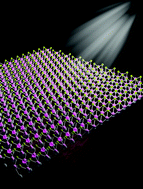Prediction of an extremely long exciton lifetime in a Janus-MoSTe monolayer†
Abstract
The electron–hole separation efficiency is a key factor that determines the performance of two-dimensional (2D) transition metal dichalcogenides (TMDs) and devices. Therefore, searching for novel 2D TMD materials with a long timescale of carrier lifetime has become one of the most important topics. Here, based on time-domain density functional theory (TD-DFT), we propose a brand new TMD material, namely Janus-MoSTe, which exhibits a strong built-in electric field. Our results show that in the Janus-MoSTe monolayer, the exciton consisting of an electron and hole has a relatively wide spatial extension and low binding energy. In addition, a slow electron–hole recombination process is observed, with a timescale on the order of 1.31 ns, which is even comparable to those of van der Waals (vdW) heterostructures. Further analysis reveals that the extremely long timescale for electron–hole recombination could be ascribed to the strong Coulomb screening effect as well as the small overlap of wavefunctions between electrons and holes. Our findings establish the built-in electric field as an effective factor to control the electron–hole recombination dynamics in TMD monolayers and facilitate their future applications in light detection and harvesting.



 Please wait while we load your content...
Please wait while we load your content...